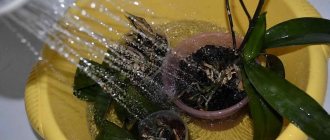Do you have an orchid growing, but you don’t know how to replant it at home? Read the article, it contains a lot of useful tips and instructions.
The orchid, just like the rose, can be called the queen of flowers. Graceful flowers, decorative leaves, intertwining roots and stems create a plant of incredible beauty. But this flower, like all the others, needs good care, an important component of which is replanting. It needs to be done correctly and on time - the further development of the plant and the abundance of flowering, as well as the duration of the adaptation process, depend on this.
Read another article on our website that tells how to propagate an orchid at home with children, cuttings, roots, and seeds. All methods are described in detail.
This article describes the timing, as well as the rules for transplanting a home orchid. You will learn how to replant a flower after the store and why to do it at all. Read on.
Why replant an orchid when grown at home: is it replanted at all, is it possible?
Orchid transplantation at home
Various circumstances may arise under which a transplant is performed. Why replant an orchid when growing it at home? Is it possible to replant at all? Yes, this can and should be done. Here are the circumstances under which flower breeding experts advise doing this:
- Replanting is required once every 3-4 years after purchasing or replanting the plant.
- If it is noticed that the roots have begun to appear from the pot, i.e. it has become too small for the plant.
- If the orchid is very sick, all its leaves begin to turn yellow.
- Unsightly appearance and condition of the substrate in which the flower grows. Mold or severe dryness of the upper fragments has appeared on the surface, which indicates a loss of the filler’s ability to pass water and air.
- The plant does not bloom for several years, and then it needs a good shake-up in the form of a transplant.
- If necessary, divide the orchid.
If these signs are not observed, it is better not to touch the orchid - it does not really like to be disturbed. It is also not recommended to do this during the flowering process; it is better to wait until it is over, unless an urgent transplant is needed.
When do orchids need replanting?
Healthy orchids tolerate replanting very easily. However, this does not need to be done often. The presence of a large number of roots that grow past the pot does not mean that this is necessary. Transplantation is necessary if the bark loses its original properties. This usually happens 2-3 years after the previous planting. In addition, replanting is required in case of prolonged waterlogging and immediately after purchase.
Timing: when can an orchid be replanted?
Replanting an orchid at home
This operation should be carried out when the dormant period of the inflorescences and the entire plant has ended. But there are types of orchids in which the dormant period is weakly expressed, for example, phalaenopsis, which blooms almost all year round with short breaks. Therefore, if new shoots of a plant do not develop in the absence of signs of disease, it means that it is entering a dormant period. This is the best time to replant. This time usually occurs in the spring - late February and March. This is the best time to replant an orchid.
Preparation
It is advisable to carry out the planned replanting in the spring, because at this time the flower is actively vegetating and can more easily withstand stress.
5-6 hours before transplanting, you can immerse the orchid in water so that the healthy roots are more noticeable.
If it blooms, then 2 days before the procedure the peduncle is cut off. For better air access to the leaves, wipe them with a damp, soft material. Prepare:
- substrate;
- container;
- gloves;
- sharp and disinfected knife and pruning shears.
Frequency of orchid transplantation at home: how often?
Replanting an orchid at home
Many novice flower lovers ask the question: “How often to replant an orchid?” . What determines the frequency of transplanting inflorescences at home?
- The answer to this question depends on what composition of the substrate is in the container.
- It may consist of moss, and then it needs to be replanted more often - once every two years .
- If the main part of the substrate is bark, which decomposes more slowly, then you can replant it once every three years.
Of course, these dates are indicated for planned replantings, when the inflorescence looks completely healthy and has no signs of damage by insects.
Preparing for transplant
To know how to properly transplant an orchid into a new pot, you need to understand the intricacies of preparing for this important operation.
First of all, you should remember - three to four days before transplantation, or better yet a week, you need to stop watering. Unless the house is too hot, in which case it is advisable to move the pot to a shaded place where it is not so hot. Experienced florists recommend replanting orchids when their roots are slightly dry on the outside (but not completely dry!). When the substrate in the pot is completely dry, move on to the next step and try to figure out how to transplant the orchid into another pot.
Substrate for orchid transplantation at home: what is it made of?
Substrate for transplanting orchids at home
To transplant orchids at home, you need to choose a high-quality substrate. The health and further flowering process of the plant largely depends on this. What is it made of? You can buy a specialized one at retail outlets, but it comes in two types:
- For epiphytic (i.e. with aerial roots). It's called Phalaenopsis Mixture.
- For terrestrials - “Mixture for Cymbidium”.
The first mixture is used for flowers growing on trees with long aerial roots. Therefore, the substrate for them must be breathable, because the roots of these flowers take part in photosynthesis and they do not need soil, only moisture, to grow. The composition of such mixtures usually includes:
- Pine bark
- Ground fern root
- Activated carbon
- Cut cork
- Sphagnum in small quantities
The second type of mixture is denser, because it is intended for orchids living on the ground. It contains more of these ingredients:
- Sphagnum moss
- Lowland peat
- Leaf ground
- Coal
Sometimes various synthetic materials, such as perlite or foam, are used as a substrate. You can also use:
- Expanded clay
- Shell rock
- Pumice
The substrate can be made at home. Pine bark is used for this:
- First disinfect it - hold it over steam for half an hour or boil it in water.
- After this, dry and boil again. This treatment kills all pathogenic organisms.
- Place to dry again and then cut into pieces up to 2 cm .
To the bark prepared in this way, add dry and finely chopped sphagnum moss and just a little peat coal. You can now fill the pots with this mixture.
How to properly transplant an orchid into another pot: step-by-step instructions
When planning to replant orchids, you need to remember that this is a delicate and fragile plant. Its roots are sensitive to damage, and the substrate consists of particles of bark, coal, pebbles, and foam. For work, it is important to prepare a workplace and some tools:
- wide comfortable table and table lamp;
- pots of suitable volume and shape;
- components for the substrate or ready-made soil;
- sharp pruning shears with narrow blades or scissors;
- charcoal powder for sprinkling the cuts on the roots;
- potassium permanganate, Fitosporin;
- a bowl for soaking plants;
- thin wooden sticks or tweezers for distributing pieces of substrate;
- sticks and “crabs” for tying flower stalks.
Selection of capacity
In nature, tropical orchids (they are the ones that are popular in indoor floriculture) are epiphytes. They grow attached to other plants and their roots are not buried in the soil. The plant feeds through photosynthesis, which occurs not only through the leaves, but also through the roots.
Strictly speaking, an orchid does not need a pot at all. The flower can be grown on a large piece of bark or a pile of sphagnum moss placed in an aquarium (to create high humidity). Potted cultivation of orchids is practiced because of the ease of caring for the plantings.
A pot for growing an orchid, you need to choose a transparent or translucent one. The most common material is plastic or glass.
It is mandatory to have a large number of drainage holes in the bottom and on the lower part of the side walls. Orchid roots are extremely sensitive to waterlogging. In gardening stores you can now find containers for orchids in the form of a transparent “fence” that is placed on a tray. In such a “cage” the roots of the flower are as comfortable as possible.
The size of the container should be slightly larger than the root ball. It is enough that the distance from the roots to the walls of the pot is 1 cm. A large pot and, accordingly, a large volume of substrate leads to the accumulation of excess moisture and the risk of rot.
On a note. A slight protrusion of the orchid’s roots “through the top” of the pot is normal.
Suitable substrate
The orchid makes a simple requirement for the substrate - it must be loose, allow air and light to pass through. Usually they use pine bark crushed into pieces 10-25 mm in size. You can buy it in a store, or collect it from a fallen tree in the forest. The bark collected in the forest must be removed from excess resin by freezing it outside and boiling in water for about half an hour.
When preparing soil for orchids, take 3 parts of pine bark:
- 1 part charcoal in pieces (it is needed as an absorbent);
- 0.5 parts of sphagnum moss;
- 1 part expanded clay (a weighting agent so that the flower pot does not tip over).
Sometimes, to add looseness to the substrate, pieces of foam and pumice are added.
Important! If the old soil in which the flower grew does not contain pathogens or pests, it is added to a new sterile substrate. This helps populate the new soil with microflora beneficial to the orchid.
There are other options for substrates for orchids.
Coconut fiber.
Available in the form of pressed briquettes, which are soaked in water before use. After drying, coconut fiber is used to plant a flower or added to the soil mixture.
Coconut fiber has a neutral reaction and is highly resistant to rotting.
Sphagnum moss (live).
It perfectly maintains the required substrate humidity and allows air to pass through well. To maintain the life of the moss itself, it is important to water (spray) it only with purified (distilled) water.
Expanded clay, pumice, pebbles.
They can act both as drainage and as complete soil for orchids. Particle sizes should not exceed 2.5 cm.
It has no global significance for the plant which particular composition of the substrate the grower chooses. Comfortable temperature, humidity (soil and air), regular fertilizing, and lighting are of greater importance for the successful development of a seedling.
Preparing a flower for transplantation
On the eve of transplantation, 2-3 hours before, place the pot with the orchid in a pan of water. Roots saturated with moisture become elastic and flexible, less brittle.
The flower is carefully removed from the pot. Sometimes, to safely remove an orchid, you have to cut the container because the roots have grown into the drainage holes. The substrate is shaken off the roots. Carefully rinse the root ball in a pale pink solution of potassium permanganate or Fitosporin. You can hold the plant in a disinfectant solution for 10-15 minutes (relevant for store-bought orchids).
Carefully inspect the roots for rot and pests. Dry, broken, brown shoots are cut out with pruners or scissors. The sections are sprinkled with charcoal powder.
Important! If pests are found in the substrate, the orchid is bathed in an insecticide solution.
Plants prepared in this way are left to dry on the table for 3-5 hours.
Planting an orchid in a pot
Due to the lightness of the substrate and the large peduncle of some orchids hanging to the side, it is necessary to take care of the stability of the pot. Drainage from pebbles is poured into the bottom of the container (even if there are many holes in the pot) or a large pebble is placed.
The orchid is placed in a pot with the roots straightened or rolled into a ring. Simultaneously with filling the pot with soil, a support for the future peduncle is installed in the center of the container. To prevent it from slanting, it is firmly fixed in the drainage layer.
Pieces of the substrate must be pushed between the roots with tweezers or a stick and distributed evenly inside the container. The root collar (if the base of the flower can be called that) should be 1.5 cm below the edges of the container. If some roots stick out a little from the pot, this is not a problem.
Which pot is best to replant a home orchid?
It is better to replant the orchid in a transparent pot.
Most orchids have large roots that like to entwine the pot from the inside and even look out. Therefore, when choosing a new container for a flower, you need to focus primarily on the size of the root system. But, given that the base of the flower will grow further, you need to add a few centimeters to the diameter. Which pot is best to replant a home orchid?
Worth knowing: For a large orchid with intensive growth, you can buy a pot, as they say, “for growth,” so as not to replant it often.
Orchid lovers most often grow their “beauties” in plastic transparent pots or containers. What are the advantages of such containers? Here is the answer:
- The roots are clearly visible and you can constantly monitor their condition. With normal soil moisture, the roots are usually green, but as the substrate dries, they gradually turn gray, which indicates the need for watering.
- In plastic containers, unlike clay ones, the roots do not grow to the walls of the container and therefore are not injured during replanting.
Although clay containers have their advantages:
- In them, the base-root does not overheat, which is very important for orchids.
- Do not overwater the plant because the moisture will last longer.
- In addition, a clay pot is much heavier than a plastic one and therefore will not tip over. Orchids are planted in such pots, some of the roots of which completely dry out and die during the dormant period.
Be sure to make drainage holes in the containers. This will provide the roots with faster drying and ventilation, which will protect them from rotting. Flower lovers with no experience often overwater the plant for fear of drying it out. Drainage holes will help in this case too.
Worth knowing: Plastic containers have one drawback - they have a rather simple, not very sophisticated appearance, compared to the flower itself. To correct this shortcoming, you can buy a beautiful flowerpot that will completely hide the plastic.
There is another way out - you can put a plastic pot in a low glass vase. The space between the walls of the vase and the pot is filled with some kind of jewelry or tinsel, balls or floral fillers. This needs to be done carefully so that the multi-colored filler does not distract from the beauty of the orchid flowers.
Remember: Do not buy large containers for orchids. In small ones - up to 15 cm in diameter, it feels much better and blooms longer.
Landing Features
When planting a plant in a certain container, there are some nuances that must be taken into account so that the roots develop well.
In a transparent plastic pot
Coarse and fine bark are mixed into a transparent pot, and then planted so that the root collar is above the surface . This does not cause any particular difficulties even for a novice amateur.
In a glass container
2-3 cm of expanded clay is placed at the bottom of a glass container, and since the condensate does not completely disappear from the walls of the vessel, after six months you have to change the substrate , and this can harm the plant.
In an opaque container
It is necessary to use large bark so that light penetrates at least through the top for photosynthesis of the root system. Plus, large bark will leave voids through which air will penetrate.
Whatever pot is chosen for cultivating an orchid, glass or plastic, transparent or opaque, the main thing is to organize proper care for the plant in the subsequent period of its life.
How to transplant children, one child, a shoot of a home orchid: step-by-step instructions
Replanting a baby home orchid
An orchid growing in normal, ideal conditions can produce young shoots, or babies. This is a great opportunity to propagate the plant. What should be done? How to transplant children, one child, a shoot of a home orchid? Here are the instructions step by step:
- The baby should have fairly long roots - more than 5 cm and 3-4 leaves - these are the most suitable parameters for transplantation.
- Children usually appear on the stem or near the root collar. Using a sharp knife, you need to cut off part of the stem with the baby, stepping back to the sides at a distance of about 1 cm . Sprinkle the cut area with coal.
- Prepare a small glass in advance, preferably a plastic one, and add a small layer of drainage.
- Place the baby in a glass and carefully cover it with substrate. for the first 3-4 days .
- Place the glass with the baby in a place where the air humidity is high. You can simply spray the surface of the window sill where the glass is located more often. Try not to get it on the leaves.
The baby will grow in such a container for about a year, after which it can be transplanted into a larger container. An orchid grown from a child will bloom in three years .
Flower care after transplantation
Special care for the orchid after transplantation is not required, since the list of mandatory measures remains the same and includes periodic watering and fertilizing (Figure 2).
So, immediately after planting, you cannot water the flower abundantly. It is enough just to generously spray the roots and the upper part of the substrate, and full watering can be carried out only after a few days. The newly transplanted crop also does not require fertilizing: the first application of fertilizers is carried out after about a month.
Proper watering
Proper watering plays a key role in successful cultivation. You cannot water the flower in the traditional way, from above from a watering can. To saturate the plant with moisture, you need to fill a large container with water and place the flower pot inside.
Figure 2. Proper watering of a flower
Only with this method of watering will moisture flow directly to the roots, and the substrate will not be too moist. The water for watering should be at room temperature, and you should leave the pot with the plant in the liquid for only 10-15 minutes.
Further proper care of the phalaenopsis orchid plant after transplantation, growing conditions
After replanting, you need to provide proper and timely further care for the orchid. Here are the conditions for growing a phalaenopsis orchid plant:
Proper care of an orchid is to shade the window so that the sun does not burn the leaves of the flower.
- As mentioned above, immediately after the transplantation is made, the container is placed on a sunny windowsill for a week, but shaded from direct sunlight. Otherwise, if this is not done, the orchid leaves will lose their decorative appearance, wrinkle and become wilted.
You can water the flower after transplanting only after a couple of weeks.
- water the plant after replanting only after 2 weeks . The fact is that orchid roots are susceptible to various fungal diseases. Therefore, the root system needs to be slightly dried to avoid this. Find out how to properly water an orchid here .
Spraying the plant so as not to dry it out
- But, in order not to dry out the plant, spray the leaves, or, even better, wipe them with a wet sponge. In this case, under no circumstances should water get into the depths of the rosette of leaves. This can lead to their rotting.
Orchid grows at optimal temperature
- It is important to maintain optimal temperature. The orchid does not like heat, it needs a temperature no higher than +21-22°C , but it should not fall below 18°C . Otherwise, the inflorescences get stressed, which is very undesirable for these sissies.
Feed the orchid
- A blooming orchid needs feeding. Use only mineral mixtures. Organic ones are not suitable for feeding flowers, since they can introduce diseases into the soil.
Excessive nitrogen nutrition can cause leaf growth to the detriment of flowering. Nowadays you can find special fertilizer compounds for orchids in stores. In any case, it will be good to use an all-purpose fertilizer for flowering plants. They must be diluted strictly according to the instructions so as not to harm the flower. They need to be added along with water for irrigation.
Features of the growth of orchids in nature
We are accustomed to the fact that representatives of the plant world need land. But home orchids are original in this matter. The thing is that most varieties of indoor orchids that are grown in our country have a common ancestor - the phalaenopsis orchid. This plant prefers to settle on the bark of trees and, in fact, feeds on it, and in the process of digestion it is helped by symbionts - fungi and parasites. The roots of the plant are partially in the air, in direct sunlight, and during rainstorms they are completely washed by water.
That is why the question is not only when to transplant an orchid, but also how to do it correctly. Obviously, the experience gained from growing other flowers will not help here.
If there is no flowering after transplantation: what to do?
Lack of flowering after transplantation
After transplantation, the orchid should increase its green mass and bloom after a certain time. This usually happens after 3-4 months . But what if the inflorescences do not appear for much longer? What to do if there is no flowering after transplantation? This problem can occur for several reasons:
- The plant is overfed with nitrogen fertilizers , active leaf growth is observed, they become larger than they should be during normal development. In this case, feeding should be stopped for a month.
- The transplant was not carried out in a timely manner . For example, if for some reason an orchid was transplanted at the time when it bloomed last year, then it most likely will not bloom this year. The plant will direct all its energy to restoring its root system, and not to flowering.
- Perhaps you made mistakes during transplantation . If the plant is not firmly fixed in the substrate, then when you move the pot, it begins to dangle in it, and the roots and stems will receive microtrauma. The plant does not have the opportunity to direct its energy to flowering, experiencing constant stress.
- Insufficient lighting and low humidity . You need to move the pot to a lighter windowsill and spray its surface to increase the humidity of the surrounding air.
Follow these tips, and your flower will soon delight you with its unique blooms. It's worse when the plant begins to wilt. What to do? Read on.
Reasons for transplant
Transferring a flower to a new pot can be planned when the root system has developed so much that it does not fit in a tight container and comes out through the drainage holes.
There are many more reasons for an emergency transplant:
- The soil settled, came into clumps and there was a lot of space in the pot. Most often, a low-quality substrate behaves this way.
- There is a smell of dampness, rot, and too much water remains in the pot after watering.
- The roots have changed color and become gray or brown.
- Visually, the flower began to look depressed and weakened.
- Doesn't bloom for more than three months.
Green plaque
The green coating in the orchid pot is formed by algae. Some gardeners consider it harmless, but it is always a symptom of waterlogging. Algae worsen the quality of nutrition and flowering, and increase acidity. The substrate loses the necessary looseness, drainage and air exchange decrease.
If the orchid has noticeably reduced growth and the leaves are withering, then replanting as a rescue from algae plaque will be a necessary measure.
Filling the entire volume of the container with roots
The root system of an orchid increases significantly in volume with age. The flower loves close quarters, but if the roots have already woven into a tight ball and rested against the walls, then transferring it to a larger container is simply necessary. Inactive formation of aerial roots outside the pot is considered normal and nothing is done to the plant.
Weaving and damage to roots
Through the transparent walls of the pot, the degree of intertwining of healthy roots with dead ones is clearly visible. In this case, transplantation is needed to remove outdated, diseased and injured areas.
Plaque and spots on the roots
If the orchid is properly maintained, the spores of pathogenic microorganisms are dormant in the soil. But when favorable conditions for reproduction occur, they instantly appear in the form of a gray, white coating.
Main reasons:
- high humidity and intensive watering;
- the room is too warm;
- lack of lighting;
- the roots became infected from leaves that were not removed in time.
Brown spots indicate the presence of fungus or salinization of the substrate with hard water.
Surgical replanting is required when more than half of the roots are affected, which will have to be removed to stop the rotting process.
The appearance of pests in the substrate
Parasitic insects are dangerous because they feed on the sap of the plant and thereby weaken it. Most often the substrate is inhabited by:
- Podura (springtail) - damages young roots, loves acidic soil;
- snails live in the ground during the day and crawl to the surface at night;
- mealybug - lives in the roots, at the base of the flower;
- woodlice is a soil parasite that eats any parts of the plant, causing their death.
Replanting into new soil, washing the roots and treating them with special preparations will save you from pests.
Withering
Too dense a substrate is a common cause of wilting of leaves and peduncles. The roots do not have enough oxygen, they die and cease to fully supply the above-ground part with nutrition. Transplanting into a new specialized soil will correct the situation.
Lack of buds
Some types of orchids do not want to bloom, even if conditions permit. Then the transplant can be used as stress, which will force the orchid to throw out the peduncle.
Only mature and healthy plants are stimulated in this way.
What to do if your home orchid withers after transplantation?
A home orchid withers after transplantation.
Most likely the plant is sick. If planting rules are violated, when mechanical damage to the roots occurs, the leaves do not receive full nutrition. What to do if your home orchid withers after transplantation? Here are the tips:
If you watered a lot, replant the plant:
- With good watering and stagnation of liquid at the bottom of the container, especially if there is no drainage, the roots may begin to rot.
- Then the wilting will soon be replaced by yellowing of the leaves and the plant may die.
- Here an emergency orchid transplant will be needed to save it.
Control pests:
- Another reason could be a pest attack.
- Spider mites, the worst pests of indoor plants, thrive in dry air.
- It can be difficult to notice them right away - they are very small and the bad effects begin to appear when there are a lot of them.
- Whiteflies and scale insects also harm orchids. Providing optimal air humidity will help to significantly reduce the number of these insects.
Protect from the sun:
- If the orchid is not protected from direct sunlight, its leaves will begin to wilt.
- This indoor flower feels best on windows that face east, where the sun appears only in the morning and for a short time.
Containers must be provided with drainage holes, and they need to be made not only at the very bottom of the container, but also on the sides to ensure good air exchange for the roots.
When will it bloom?
When growing home orchids in a pot, florists value them for their beautiful flowers. Of course, they are interested in how long after transplantation the plant will begin to bloom.
In fact, orchids are easier to replant than most house plants. Therefore, if everything was done correctly, it will bloom in due time. An exception may be cases when the transplant was carried out shortly before the buds opened. At the same time, the orchid will probably shed its buds so as not to waste excess moisture and nutrients on the flowers.
How to properly water a home orchid flower?
Well-groomed orchid flowers
Watering a home orchid flower is carried out by immersion in water, the temperature of which is not lower than +20°C , so as not to cause stress to the plant. How to do this correctly? Here is the answer:
- To do this, take a cup with warm liquid and place the container with the plant in it for 20 minutes .
- Then take it out and place it on a wire rack to drain off excess water.
- Then place the flower in its usual place.
In winter, the number of waterings should be reduced, but in summer, on the contrary, this should be done more often, at least twice a week. It is necessary to monitor the pseudobulb - if it has lost turgor, then watering is necessary.
Important: It is forbidden to take long breaks between waterings. The orchid is a tropical plant that naturally lives in times of frequent rain and high humidity. Therefore, drought is detrimental to it.
Problems and difficulties during transplantation
- The plant is difficult to remove from the container . If the orchid's roots have grown greatly and come out through the drainage holes, then the plastic pot can be cut with scissors without damaging the roots.
- The old soil has turned into a lump and is not separated from the roots . Place the plant in warm water to soak the soil. Wash off any remaining soil from the roots with a warm shower and dry them thoroughly before planting.
- Pests were discovered during transplantation . Rinse the roots with running water and disinfect with solutions that can be purchased in specialized stores.
Growing orchids just seems like a complicated process. With the right approach and compliance with all the technological subtleties of caring for them, you can easily achieve success in this matter.
How to replant an orchid flower if the root is rotten: tips
Replanting an orchid flower if the root has rotted
Infrequently, but there are cases when novice gardeners, as a result of improper care, have the roots of an orchid rot. This can happen to all the roots or to a large part of them at once. Is it possible to save the plant then? How to replant an orchid flower if the root is rotten? Here are the tips:
- To revive orchids whose roots have completely died, you need a small window greenhouse.
- In the container where the leaf rosette will be located, you need to pour a small layer of drainage - this can be expanded clay or pebbles.
- Place sphagnum moss on top, which is previously kept over steam and dried.
- Now moisten the substrate and place the leaf rosette in it.
- Transfer to a greenhouse, where a constant temperature should be maintained within +21 - +27°C and high humidity of about 100% . The light should be bright, but diffused - direct sunlight is detrimental to leaves during this period.
After 3-4 weeks of this regime, root rudiments will begin to appear at the base of the leaf rosette and then they will begin to grow. Epin , to the water for irrigation .
If a diseased orchid has several living roots left, or even just one, the chances of saving it increase:
- After trimming the rotten roots, you need to rinse the remaining living roots under warm water and sprinkle the cut areas with charcoal.
- A pre-prepared pot up to 8 cm in diameter is filled with ordinary substrate and a leaf rosette with roots is planted in it.
- Next, the plant is treated as in the first case, placing it in a greenhouse.
If everything went well, new roots will begin to grow in 2-4 weeks .
Step-by-step instructions for transplantation
In a larger container
- Prepare the soil, container for replanting, expanded clay, activated carbon and scissors. Treat scissors, pot and expanded clay with an antiseptic solution.
- Remove the plant from the old flower pot. Inspect the roots of the orchid and remove all rotten shoots with scissors. Sprinkle the cut areas with crushed activated carbon.
- Fill the bottom with expanded clay and a small layer of soil. Place the plant in the container, straightening the roots, and cover all free spaces with soil, periodically pressing it down.
Slightly less
Many varieties of orchids like tight spaces . For such flowers, choose a container a couple of centimeters less than the volume of the root system. Also, a smaller size is needed if the plant was damaged when rotten roots were removed, and their volume was greatly reduced.
- Prepare everything you need for transplantation, pre-treating it with an antiseptic.
- Inspect the roots and remove rotten areas. Treat the cut areas with crushed activated carbon.
- Place expanded clay at the bottom of the container and sprinkle it with soil. Place the orchid so that there is room for new shoots. To do this, move the old part to the edge of the pot.
Opaque
- Take a pot, scissors, soil, activated carbon and expanded clay. Disinfect necessary materials.
- Inspect the roots and remove any rotten ones. Treat the cut with activated carbon.
- Pour expanded clay and soil onto the antiseptic-treated bottom. Install the flower, straighten the roots, fill the free spaces with soil. In this case, you need to focus on the view of the root system through the open part of the pot, and this greatly complicates the planting process.
Is it possible to replant a flowering orchid while it is blooming?
You can replant orchids during flowering, but in the most urgent cases.
There is only one situation in which you can replant a blooming orchid - if it is in danger of dying for any reason and you need to choose one of two:
- The orchid will fade, but then die, having spent its last energy on flowering.
- The peduncle is cut short, but later with good care, the plant is completely restored and after a while it will bloom again.
What to do in the second case? Adviсe:
- Prepare fresh substrate and pot. How to do this has already been said above in the text.
- Cut the flower stalks of the orchid to about 2/3 of the length. By the way, the flowers can be placed in water - they will last for almost a week.
- Carefully remove the plant from the pot and inspect the roots, cutting out any rotten ones.
- If the substrate is in normal condition, i.e. there is no mold or its smell, it is not overdried or, on the contrary, very waterlogged, then in this case you need to try to preserve it as much as possible without shaking off the roots. Otherwise, proceed as with a regular transplant, the procedure of which has already been described.
- Now you need to place the plant in the pot and secure it well there.
All that remains is to put the orchid, transplanted during flowering, into the greenhouse and observe how it will feel further. Do not forget to follow all the rules for caring for this flower, which are no more complicated than the rules for caring for other indoor flowers.
Correctly replanting the plant
First you need to carefully remove the plant from the pot. Often this has to be done along with the ground. Take a long, flat object (such as a butter knife) and carefully loosen the soil from the sides of the pot, loosening it a little to make it crumbly. If the soil is dry enough, there will be no problems here. Then, lifting the soil from different sides with the same knife, carefully remove the orchid from the pot. You need to act with surgical caution so as not to damage the roots.
Now you need to thoroughly rinse the root system - for example, use cool water from the shower. This will cause a lot of problems for other plants, but orchids tolerate such washing without harm to themselves. Carefully place it on a paper towel and inspect the roots. They should be green. Pay special attention to brown and gray. Carefully feel them along their entire length - there is a high probability that they have already died and are completely unnecessary. In this case, carefully trim them with sharp scissors or pruners. It is advisable to treat the cut - crushed activated carbon will do.
Now carefully spread the roots so that they point in different directions and place the plant in a new pot. Add the remaining substrate - as a result, they should not reach the edges by about 2-3 centimeters. Lightly compact the soil with your hand. Remember, only the roots themselves should be buried. There is no need to bury the base of the plant - on the contrary, it should be slightly raised above ground level.
The main work is finished! But don’t think that you have finally figured out how to plant an orchid in a pot. There are additional nuances here that you definitely need to know about.











